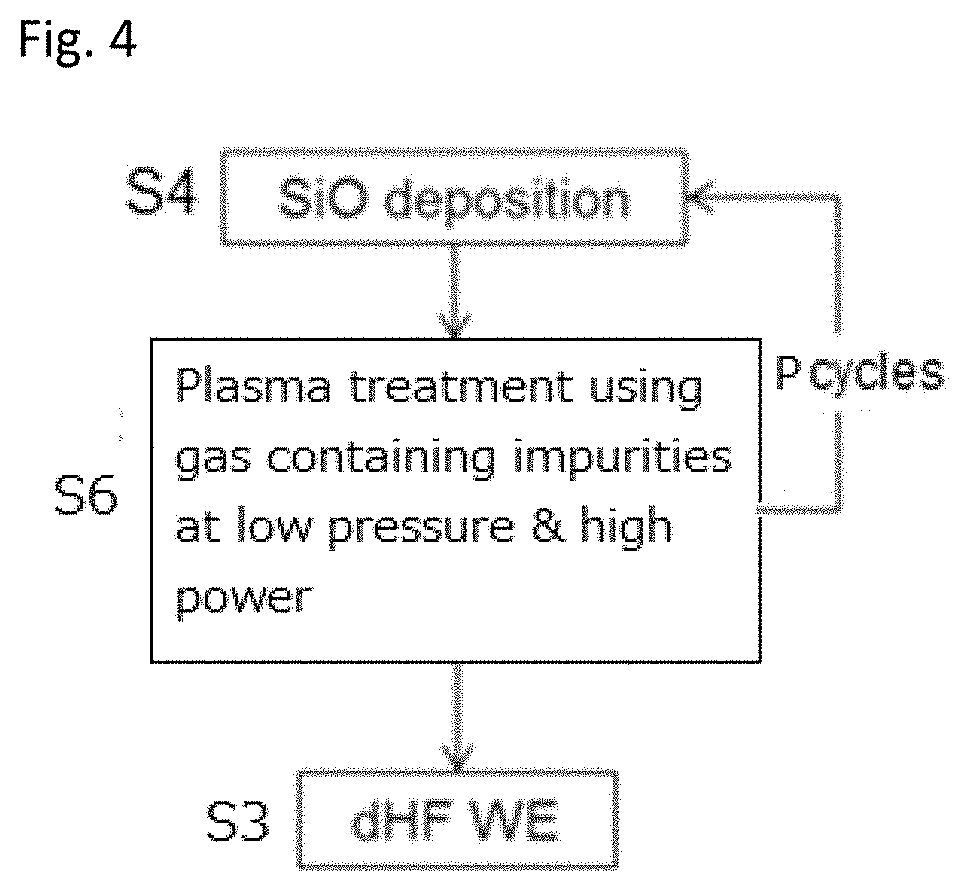Method of topology-selective film formation of silicon oxide
- Summary
- Abstract
- Description
- Claims
- Application Information
AI Technical Summary
Benefits of technology
Problems solved by technology
Method used
Image
Examples
example 1
[0065]In this example, the sidewall-thick TS—SiO by area-selective incorporation of impurities was conducted as illustrated in FIG. 4. However, this example was rather an experimental example, since step S6 in FIG. 4 was conducted using polyimide tape (with an acryl adhesive) with which a substrate adhered to a susceptor, which tape was exposed to a plasma and expected to be a source of impurities including carbon (airborne-molecular contaminants, AMC) which was released into the plasma, forming a plasma containing active species of carbon (as opposed to forming a plasma containing active species of impurities by adding a gas containing impurities to a plasma gas). The above step is considered to be functionally equivalent to step S6, wherein both steps produce a plasma containing active species of impurities.
[0066]First, a SiO film was formed on a Si substrate (Φ300 mm) having trenches by PEALD, one cycle of which was conducted under the conditions shown in Table 5 (deposition cycl...
reference example 1
[0072]In this reference example, consistent with the above in Example 1, it was confirmed that impurities (carbon and nitrogen) were incorporated into a film by plasma treatment at a low pressure, and a portion of the film containing more impurities was more vulnerable to wet etching.
[0073]A film (blanket film) was deposited in a manner substantially similar to that in Example 1, and then, the film was exposed to a plasma in a manner substantially similar to that in Example 1 except that the treatment pressure was changed as shown in FIG. 7, followed by wet etching in a manner substantially similar to that in Example 1. FIG. 7 is a graph showing the relationship between treatment pressure [kPa] and wet etch rate (“WERR. Tox”: wet etch rate relative to thermal oxide) of the films. As shown in FIG. 7, when the treatment pressure was 100 Pa (“No. 2”), WERR was very high (i.e., low quality film with low resistance to chemicals), whereas when the treatment pressure was 500 Pa, 2,000 Pa, ...
##ic example 1
Prophetic Example 1
[0076]In this example, the sidewall-thick TS—SiO by area-selective incorporation of impurities is performed as illustrated in FIG. 3. A SiO film is deposited in a manner substantially similar to that in Example 1 as step S4 in FIG. 3. In place of use of polyimide tape with an acryl adhesive in Example 1, upon deposition of the film, without breaking a vacuum, CxHy gas (x and y are integers other than zero) and Ar are introduced to the chamber at about 0.5 slm and about 2 slm, respectively, so as to expose the film to the hydrocarbon gas for about one minute, thereby adsorbing impurities (e.g., carbon) onto a surface of the film. Thereafter, step S2 in FIG. 3 is conducted under conditions similar to those for the plasma treatment in Example 1, followed by wet etching (step S3 in FIG. 3) under the conditions similar to those in Example 1. As a result, the sidewall-thick TS—SiO having a topology similar to that shown in (c) in FIG. 6 is achieved.
PUM
| Property | Measurement | Unit |
|---|---|---|
| Fraction | aaaaa | aaaaa |
| Pressure | aaaaa | aaaaa |
| Dielectric polarization enthalpy | aaaaa | aaaaa |
Abstract
Description
Claims
Application Information
 Login to View More
Login to View More - R&D
- Intellectual Property
- Life Sciences
- Materials
- Tech Scout
- Unparalleled Data Quality
- Higher Quality Content
- 60% Fewer Hallucinations
Browse by: Latest US Patents, China's latest patents, Technical Efficacy Thesaurus, Application Domain, Technology Topic, Popular Technical Reports.
© 2025 PatSnap. All rights reserved.Legal|Privacy policy|Modern Slavery Act Transparency Statement|Sitemap|About US| Contact US: help@patsnap.com



